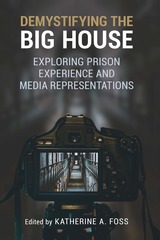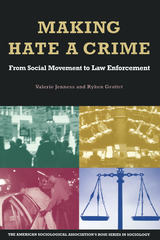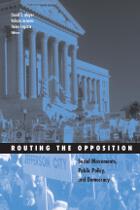3 books about Jenness, Valerie

Demystifying the Big House
Exploring Prison Experience and Media Representations
Edited by Katherine A. Foss
Southern Illinois University Press, 2018
Essays in this volume illustrate how shows such as Orange Is the New Black and Oz impact the public’s perception of crime rates, the criminal justice system, and imprisonment. Contributors look at prison wives on reality television series, portrayals of death row, breastfeeding while in prison, transgender prisoners, and black masculinity. They also examine the ways in which media messages ignore an individual’s struggle against an all too frequently biased system and instead dehumanize the incarcerated as violent and overwhelmingly masculine. Together these essays argue media reform is necessary for penal reform, proposing that more accurate media representations of prison life could improve public support for programs dealing with poverty, abuse, and drug addiction—factors that increase the likelihood of criminal activity and incarceration.
Scholars from cultural and critical studies, feminist studies, queer studies, African American studies, media studies, sociology, and psychology offer critical analysis of media depictions of prison, bridging the media’s portrayals of incarcerated lives with actual experiences and bringing to light forgotten voices in prison narratives.
Scholars from cultural and critical studies, feminist studies, queer studies, African American studies, media studies, sociology, and psychology offer critical analysis of media depictions of prison, bridging the media’s portrayals of incarcerated lives with actual experiences and bringing to light forgotten voices in prison narratives.
[more]

Making Hate A Crime
From Social Movement to Law Enforcement
Valerie Jenness
Russell Sage Foundation, 2001
Violence motivated by racism, anti-Semitism, misogyny, and homophobia weaves a tragic pattern throughout American history. Fueled by recent high-profile cases, hate crimes have achieved an unprecedented visibility. Only in the past twenty years, however, has this kind of violence—itself as old as humankind—been specifically categorized and labeled as hate crime. Making Hate a Crime is the first book to trace the emergence and development of hate crime as a concept, illustrating how it has become institutionalized as a social fact and analyzing its policy implications. In Making Hate a Crime Valerie Jenness and Ryken Grattet show how the concept of hate crime emerged and evolved over time, as it traversed the arenas of American politics, legislatures, courts, and law enforcement. In the process, violence against people of color, immigrants, Jews, gays and lesbians, women, and persons with disabilities has come to be understood as hate crime, while violence against other vulnerable victims-octogenarians, union members, the elderly, and police officers, for example-has not. The authors reveal the crucial role social movements played in the early formulation of hate crime policy, as well as the way state and federal politicians defined the content of hate crime statutes, how judges determined the constitutional validity of those statutes, and how law enforcement has begun to distinguish between hate crime and other crime. Hate crime took on different meanings as it moved from social movement concept to law enforcement practice. As a result, it not only acquired a deeper jurisprudential foundation but its scope of application has been restricted in some ways and broadened in others. Making Hate a Crime reveals how our current understanding of hate crime is a mix of political and legal interpretations at work in the American policymaking process. Jenness and Grattet provide an insightful examination of the birth of a new category in criminal justice: hate crime. Their findings have implications for emerging social problems such as school violence, television-induced violence, elder-abuse, as well as older ones like drunk driving, stalking, and sexual harassment. Making Hate a Crime presents a fresh perspective on how social problems and the policies devised in response develop over time. A Volume in the American Sociological Association's Rose Series in Sociology
[more]

Routing the Opposition
Social Movements, Public Policy, and Democracy
David S. Meyer
University of Minnesota Press, 2005
On one side are the policy makers, on the other, the movements and organizations that challenge public policy. Where and how the two meet is a critical juncture in the democratic process. Bringing together a distinguished group of scholars from several different disciplines in the social sciences, Routing the Opposition connects the substance and content of policies with the movements that create and respond to them. Local antidrug coalitions, the organic agriculture movement, worker's compensation reforms, veterans' programs, prison reform, immigrants' rights campaigns: these are some of the diverse areas in which the contributors to this volume examine the linkages between the practices, organization, and institutional logic of public policy and social movements. The authors engage such topics as the process of involving multiple stakeholders in policy making, the impact of overlapping social networks on policy and social movement development, and the influence of policy design on the increase or decline of civic involvement. Capturing both successes and failures, Routing the Opposition focuses on strategies and outcomes that both transform social movements and guide the development of public policy, revealing as well what happens when the very different organizational cultures of activists and public policy makers interact.
[more]
READERS
Browse our collection.
PUBLISHERS
See BiblioVault's publisher services.
STUDENT SERVICES
Files for college accessibility offices.
UChicago Accessibility Resources
home | accessibility | search | about | contact us
BiblioVault ® 2001 - 2024
The University of Chicago Press









